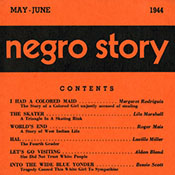Alice Browning Papers
Finding Aid: Alice Browning Papers
Repository:
Chicago Public Library, Carter G. Woodson Regional Library, Vivian G. Harsh Research Collection of Afro-American History and Literature
 The Alice Browning PapersAlice Browning was a writer and publishing
entrepreneur, best known as the founding editor of Negro Story magazine
(1944-1946) and the founder of the annual International Black Writers
Conference (1970-present). A lifelong teacher at Forrestville
Elementary School in Bronzeville, Browning studied for a Master's Degree
in English at Columbia University in 1940. Frustrated by the lack of
venues in which to publish her own writing, Browning teamed with her
friend Fern Gayden, a social worker who had been a member of Richard
Wright's South Side Writer's Group in the late 1930s. With the help of
Gayden and Parkway Community House director Horace Cayton, Browning
secured permission to reprint Wright's short story "Almos' a Man."
Borrowing $200 from her husband Charles P. Browning, an executive at the
Chicago Defender, she and Gayden printed and distributed the inaugural
issue of Negro Story (pictured), which appeared in May 1944.
The Alice Browning PapersAlice Browning was a writer and publishing
entrepreneur, best known as the founding editor of Negro Story magazine
(1944-1946) and the founder of the annual International Black Writers
Conference (1970-present). A lifelong teacher at Forrestville
Elementary School in Bronzeville, Browning studied for a Master's Degree
in English at Columbia University in 1940. Frustrated by the lack of
venues in which to publish her own writing, Browning teamed with her
friend Fern Gayden, a social worker who had been a member of Richard
Wright's South Side Writer's Group in the late 1930s. With the help of
Gayden and Parkway Community House director Horace Cayton, Browning
secured permission to reprint Wright's short story "Almos' a Man."
Borrowing $200 from her husband Charles P. Browning, an executive at the
Chicago Defender, she and Gayden printed and distributed the inaugural
issue of Negro Story (pictured), which appeared in May 1944.
The Alice Browning Papers at the Chicago Public Library, Carter G. Woodson Regional Library, Vivian G. Harsh Research Collection of Afro-American History and Literature consist in manuscripts, serials, pamphlets, photographs, and ephemera from throughout Browning's life, concentrated chiefly from 1968-1985, the years when she was organizing the International Black Writers Conference. They include a complete run of Negro Story and a nearly-complete run of Browning's later publication endeavor, The Browning Letter, as well as a complete manuscript of Browning's unpublished novel Chicago Girl, which she wrote in the 1940s.









